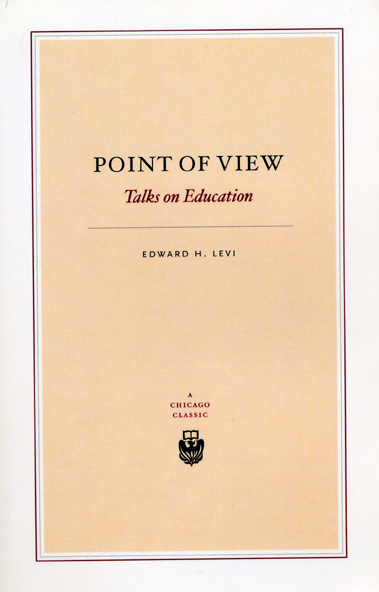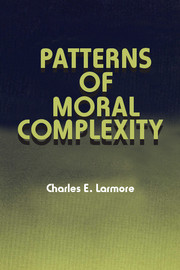In 1967, Edward Levi, the then president of the University of Chicago (he later became the attorney general of the United States), told the citizen’s board of the university that it is not the role of the university to directly respond to the needs of the broader world of politics and commerce or to be popular with the general public, and that the true mission of an academic institution is intellectual, not moral. He told them that the university does not exist to develop inventions for industry, or to train technicians for society, or to counter the injustices of the world. The central purpose of the university, Edward Levi avowed, the main reason for its existence, is “improving the stock of ordered knowledge and rational judgment.”1 Chicago: University of Chicago Press, 2007.More info →
Chicago: University of Chicago Press, 2007.More info →
For a discussion of Levi’s vision and its current fate with special reference to issues of academic freedom, see Richard A. Shweder (2014) “To Follow the Argument Where It Leads: An Antiquarian View of the Aims of Academic Freedom at the University of Chicago,” in Akeel Bilgrami and Jonathan Cole (Eds.), Who’s Afraid of Academic Freedom? Columbia University Press. Pps. 190-238.
More info →
University presidents in the United States no longer speak that way, at least not when they talk to citizen’s boards or potential nonacademic patrons. Many of them have concluded that Edward Levi’s vision of the academy is impractical and unaffordable. As far as I know, the enrichment concept in the motto of the University of Chicago (“Let knowledge grow, so life may be enriched”) was never meant to imply, “Go to college so that you can get rich” or, “Go to college so you can save the world”; nor was the adage meant to imply that the aim of the university was to engage in beneficent social engineering, human rights activism, or identity politics. Nevertheless those motives are increasingly part of a contemporary discourse used to justify public and private support for the academy, as many universities strive to become consulting agencies of sorts, setting up “urban labs” or “innovation institutes” to collaborate with nonacademic change agents (for example, politicians and entrepreneurs) and targeting their fundraising efforts (and even their mission statements) to projected practical advances in the production of energy, school reform, and health-enhancing discoveries and inventions in microbiology and molecular engineering.2 One of the jewels in the crown of the world-wide academy is the Institute for Advanced Study (Princeton, New Jersey), whose motto is “Truth and Beauty.” That choice of motto is instructive not only because of what the maxim enshrines but also because of what it sets to the side (no mention is made of “Goodness” or “Social Justice”). The dictum nods to the last lines of a well-known poem by John Keats (“Beauty is truth, truth beauty,—that is all Ye know on earth, and all ye need to know”) while identifying and embracing the motives that animate the life of a genuine scholarly mind.
There was a time during the Edward Levi era (and extending some years beyond) when the Articles of Incorporation of the University of Chicago in the preamble to the statute concerned with patent policy (statute # 18) stated that “research done primarily in anticipation of profit is incompatible with the aims of the university.” In 1980 Congress passed the Bayh-Dole Act, which commercialized the academy by offering a financial incentive to federally funded researchers and their university administrators. Universities were granted permission to patent government-funded research done on campus and to profit from such patents by developing closer ties with industry. The explicit aim of the Bayh-Dole Act (also known as the Patents and Trademark Law Amendments Act) was to facilitate the integration of academic research laboratories into the commercial marketplace by counting on the profit motive to generate social benefits. The full effects of Bayh-Dole on the intellectual climate of the academy and on decisionmaking about future research agendas and faculty hires have yet to be systematically documented. It does seem revealing, however, that those Levi-like words that once seemed so remarkable (and ennobling) in the University of Chicago Statute # 18 on patent policy (“research done primarily in anticipation of profit is incompatible with the aims of the university”) have been excised from the university’s 2010 “Restated Articles of Incorporation.”
Lost (or at least kept off center stage) during the current calls for the academy to be practical, applied, or “translational,” and amidst the clamor to directly respond to the broader world of politics and commerce, is the premise behind Edward Levi’s archetype for the modern university. That premise was powerfully and provocatively formulated in 1938 by the philosopher Arthur Lovejoy (cofounder of the American Association of University Professors) when he wrote: “The distinctive social function of the scholar’s trade cannot be fulfilled if those who pay the piper are permitted to call the tune.”3 Arthur Lovejoy (1938) American Association of University Professors (AAUP) Bulletin, 24: 409-414.
More info →
These days that premise may seem antiquarian (and its invocation jejune, naïve, or even ironic), but I believe Lovejoy’s testament to intellectual liberty and faculty autonomy was originally meant to define the conditions that make for greatness in the pursuit of knowledge and the cultivation of critical reasoning in the academy—the sort of greatness Edward Levi had in mind.
Enter Kenneth Prewitt’s “USBAR” defense of the academic pursuit of scholarly knowledge. USBAR is an acronym for a canon: “Unintended Social Benefits Appreciated Retroactively,” which essentially amounts to a defense of the virtue and long-term social benefits of free and unfettered inquiry. It is a canon for those who believe it is wise and even dignifying to resist the natural temptation to try to use one’s wealth and power to “call the tune.” I once quoted Lovejoy’s caution in a graduation speech I delivered to a cohort consisting largely of University of Chicago Business School students. I told them: “If you ever become very rich or very powerful, strive for that type of wisdom—and nobility.” It is noteworthy that Prewitt’s defense strategy requires that one be able to justify the telos of the scholar’s trade by identifying and measuring the social benefits that have flowed from its pursuit (he mentions, for example, basic scientific work in sociology on “network theory,” which was not intended to lead to the design of the search algorithms that ultimately fueled the search engine industry). Quite significantly, the USBAR defense also hypothesizes that the social function of the scholar’s trade is more likely to be fulfilled when those retroactively appreciated benefits are NOT featured as goals in academic mission statements or implemented as faculty or project selection criteria.
As I interpret it, the USBAR standard is a variation on a mode of evaluation and justification known as “indirect consequentialism,” which can be defined as, “the doctrine that whereas actions must be justified consequentially, they may have to be motivated by nonconsequential considerations.”4  Cambridge University Press, 1987.More info → The doctrine draws a distinction between practical justifications (such as those that might be persuasive to a patron) and disinterested motives (such as a non-translational love of truth and beauty for its own sake—disparaged by some these days as “the curiosity narrative”). Prewitt’s essay basically urges us to take the indirect consequentialist doctrine very seriously and to put it to the test. If I understand him correctly, he believes (or at least hopes) the doctrine can and will pass that test, for the sake of convincing potentially enlightened patrons—merchants, investment bankers, hedge fund managers, politicians, the tax paying public in a liberal democracy—that there is merit in Edward Levi’s somewhat “ivory tower” vision of the modern academy.5See Jonathan Cole’s The Great American University: Its Rise to Preeminence, Its Indispensable National Role, Why It Must Be Protected (Public Affairs Press, 2010.) for a welcome defense of basic research in the academy. Cole’s book can be viewed as a partial test of the doctrine.
Cambridge University Press, 1987.More info → The doctrine draws a distinction between practical justifications (such as those that might be persuasive to a patron) and disinterested motives (such as a non-translational love of truth and beauty for its own sake—disparaged by some these days as “the curiosity narrative”). Prewitt’s essay basically urges us to take the indirect consequentialist doctrine very seriously and to put it to the test. If I understand him correctly, he believes (or at least hopes) the doctrine can and will pass that test, for the sake of convincing potentially enlightened patrons—merchants, investment bankers, hedge fund managers, politicians, the tax paying public in a liberal democracy—that there is merit in Edward Levi’s somewhat “ivory tower” vision of the modern academy.5See Jonathan Cole’s The Great American University: Its Rise to Preeminence, Its Indispensable National Role, Why It Must Be Protected (Public Affairs Press, 2010.) for a welcome defense of basic research in the academy. Cole’s book can be viewed as a partial test of the doctrine.
More info →
The temple for critical reasoning: a.k.a. the modern academy
The contemporary academy is not the idealized modern academy.6 Indeed, even many academics now think of the modern academy as old-fashioned or insufficiently postmodern. By the modern academy I mean the one pictured by Levi and Lovejoy as the home of ardent and fearless scholars and researchers who follow the argument where it leads regardless of the practical, moral, or political consequences; scholars and researchers who are prepared to challenge received pieties and make observations (or hypothesize the existence of facts) that might be embarrassing or even infuriating to some. Regardless of anyone’s final judgment about the imagined temple for critical reasoning, it might be worthwhile to glimpse its distinctive character.
That imagined modern academy is an institution associated with a particular set of intellectual ideals: disciplined impartiality, organized skepticism, a fondness for assumption questioning dialogue and of course a love of critical reasoning. It remains to be seen whether such norms will survive the current press to be “translational” or applied, or whether those norms will retain their high value as we drift away from the ideals of the modern academy to contemporary realities where patrons increasingly view university administrators and faculty members as potential hired hands in the service of some moral, political, or commercial mission.
Collective memory matters for the conscience of any institution. So it is not surprising that the ideals of the modern academy are associated with a list of role models—some ancient, some medieval, some modern. Peter Abelard, for example, the so-called Socrates of the Gauls, who infuriated religious authorities in the twelfth century by publicly expounding diametrically opposed interpretations of biblical texts, thus nearly turning the church into a debate club. Or Pyrrho of Elis, whose school of perpetual inquiry in the third century BCE was based on the maxim “if someone asserts it, deny it; if someone denies it, assert it.” The Pyrrhonists challenged dogma by staying on the move between alternative perspectives and withholding their final assent from each and every point of view. Their aim was to reveal the presence of hidden and unproven assumptions, thereby cultivating rational judgment by making us aware of its limits. They wandered around the ancient world singing, “Anything you can do I can do meta.”
That list of academic heroes also includes some inspiring twentieth-century figures, such as Robert Merton, the sociologist of the norms of science, who described the ideal academy (what he called “a self-correcting epistemic community”) as a community populated by disputatious researchers who “do not preserve the cleavage between the sacred and the profane, between that which requires uncritical respect and that which can be objectively analyzed.”7Robert K. Merton (1973, originally 1942) “The Normative Structure of Science,” in The Sociology of Science: Theoretical and Empirical Investigations (Norman W. Storer, Ed.), University of Chicago Press, pp. 277-278.
More info → I, myself, would place the anthropologist Ernest Gellner on the list. He was not only an entertaining master of rhetorical counter-punches, but more importantly he imagined the modern academy as a place where one engaged in analysis, separating anything that can be separated from anything else, which led him to conclude that (for the well-being of the modern academy) politics, commerce, and ideologies (both religious and secular) should be kept outside the gates; and where, inside the gates (as he quipped), “the soft porn of irrationalism” had no place.8  Cambridge University Press, 1987.More info → On the list (of course) is Socrates himself, the Peter Abelard of the ancient Greeks. It is a long list, stretching across millennia.
Cambridge University Press, 1987.More info → On the list (of course) is Socrates himself, the Peter Abelard of the ancient Greeks. It is a long list, stretching across millennia.
Finally, permit me to conclude with a brief response to Prewitt’s observations concerning the “ivory tower” metaphor. He takes note of its current disrepute and negative associations—aloof, impractical, and I suppose one might add “elitist.” I confess to having a different (and more positive) set of associations. When I think of the academy as an ivory tower, I think of something rare, precious, and hard to mass produce, which in this instance (and as noted earlier) is a temple for critical inquiry where fearless (and often skeptical and disputatious) scholars and researchers follow the argument and the evidence wherever it leads, and where the life of the mind can be free, creative, and independent precisely because it has been shielded from the vested interests and pressing demands associated with the worlds of commerce, partisan politics, and religious and moral crusades.
Ivory towers of that sort are well worth defending. Edward Levi and Arthur Lovejoy believed this. Ken Prewitt believes it too, but being a realist he recognizes that we are at a point in history where we need to step outside the gates. We need to better specify the indirect consequentialist doctrine of “Unintended Social Benefits Appreciated Retroactively” (USBAR). We need to critically evaluate the assumptions in USBAR and compare them to the assumptions in various direct consequentialist doctrines of intended social benefits (for example, those embraced by the Bayh-Dole Act, which invites and entices the academy to think of itself as a commercial laboratory where production is motivated by financial incentives). And, he suggests, we social scientists need to demonstrate to our potential patrons that USBAR actually applies, even to the social sciences. Do we? Does it? What do you think?
References:
 Chicago: University of Chicago Press, 2007.More info →
Chicago: University of Chicago Press, 2007.More info → For a discussion of Levi’s vision and its current fate with special reference to issues of academic freedom, see Richard A. Shweder (2014) “To Follow the Argument Where It Leads: An Antiquarian View of the Aims of Academic Freedom at the University of Chicago,” in Akeel Bilgrami and Jonathan Cole (Eds.), Who’s Afraid of Academic Freedom? Columbia University Press. Pps. 190-238.
More info →
More info →
More info →
More info →














